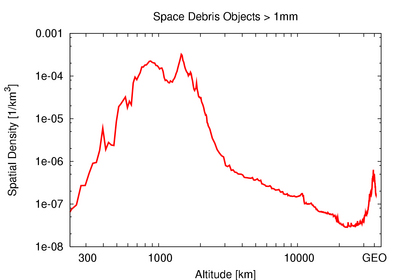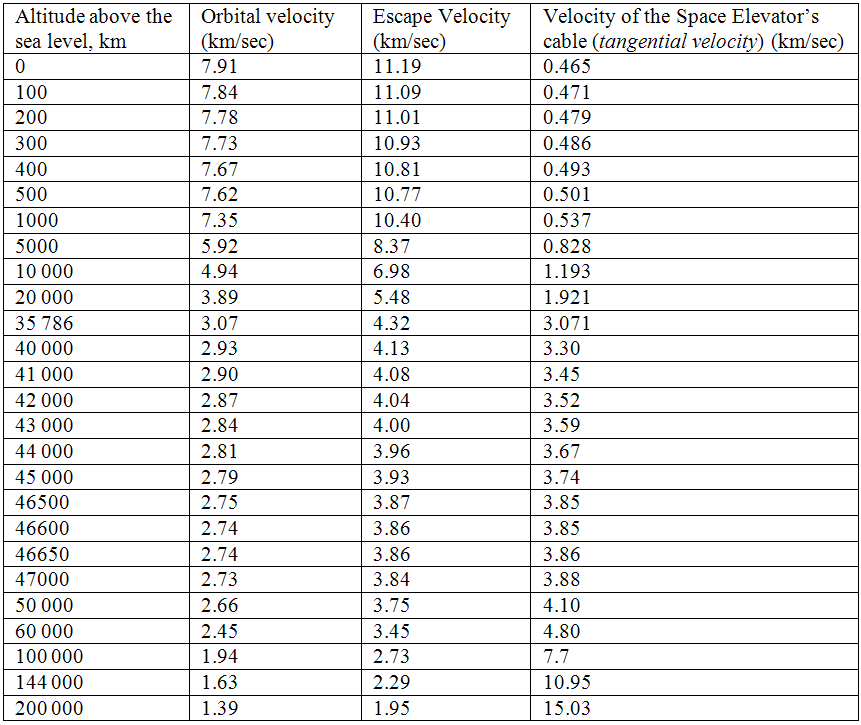OpenSpace 3: Difference between revisions
No edit summary |
No edit summary |
||
| Line 35: | Line 35: | ||
[[Image: Cxrili.gif]] | [[Image: Cxrili.gif]] | ||
We see that difference between ''Orbital Velocity'' and Space Elevator’s cable’s ''tangential'' speed at LEO (at the altitude of 300-1000 km) is quite high and the vast majority of the space debris objects are placed exactly there. | |||
Obviously, this structure cannot work operate in order to eliminate the space debris at geostationary orbit and nearby since the difference between the velocities of the satellite and Space Elevator’s cable will be close to zero and therefore no collision will occur. However, we will discuss this issue in details a bit later in this paper. | |||
Here we explain the mechanism of cleaning the LEO with these petals more thoroughly. When the space debris object pierces the petal it loses its speed and hence its orbit changes in the following manner: the circular orbit turns into the elliptical one with the apogee placed at the same altitude but with the perigee placed downwards. When the space debris object reaches the perigee it is exposed to more atmospheric drag and consequently it loses its altitude and eventually burn up in the atmosphere. | |||
Revision as of 14:41, 7 January 2011
SPACE ELEVATOR VERSUS SPACE DEBRIS
The new method for eliminating the space debris at Low Earth Orbit (LEO) and Geostationary Orbit (GEO) is presented here. The paper shows how the Space Elevator can be used in struggling against the space debris that would be possible by means of deploying the huge metallic petals onboard the Space Elevator’s cabin moving along the cable.
Introduction
The space debris is the objects in orbit around Earth created by humans that no longer serve any useful purpose. They consist of everything from entire spent rocket stages and defunct satellites to explosion fragments, paint flakes, dust and slag from solid rocket motors, and other small particles that are much more dangerous since it is more difficult to oversee them than large objects.
Since the beginning of the Space Age in 1957 a great amount of satellites have been sent into space and this increasing number is/will be (especially in future) a great problem. According to some assessments the space debris belt will very soon make problems even for putting the satellites on the orbit around the Earth. As known, more and more countries are getting involved in space exploration and therefore number of objects (both active and “dead” satellites) in space will increase rapidly. The worst thing is that the satellites are colliding to each other and thus creating more and more little objects (their fragments) around the Earth that are much more difficult to deal with than with big objects.This effect is known as “Kessler Syndrome” [1] [2]. One of such collide occurred in 2009, 10 of February when the inactive satellite Kosmos-2251 collided with active one Iridium 33 above the northern Siberia with the speed of 42 120 km/h. This collision destroyed both satellites and gave birth to one more space debris cloud consisting of numerous little objects (there are at least one thousand objects in this cloud with the size of more than 10 cm) [3]. If this tendency continues, if the critical density where the creation of new debris occurs faster than the various natural forces that remove these objects from orbit in space is reached and overcome, apparently after several ten years there will be some dust belt around the Earth.
To deal with the problem of space debris various ideas have been suggested such as: to "sweep" space debris back into Earth's atmosphere, including automated tugs, laser brooms to vaporize or nudge particles into rapidly-decaying orbits, or huge aerogel blobs to absorb impacting junk and eventually fall out of orbit with them trapped inside. We think that there actually could be one more way to deal with this problem and for this purpose we need to use the Space Elevator.
REMOVING THE SPACE DEBRIS AT LOW EARTH ORBIT
How the space debris objects could be generally eliminated? We could either decrease their speed or change their orbit(s) towards the Earth so that they to enter the atmosphere with the downward trajectory and then be burnt up. The first way: decreasing their current speed beyond lower than Orbital Velocity (or with another words-diminishing their kinetic energy) and thus forcing them to enter the atmosphere and their final burning could be very promising. In practice it could be reached by means of creating and building some physical obstacle on their way.
As well-known, the Space Elevator will be tall vertical structure built on equator and will have height of approximately several ten thousand kilometers or even more and its cable will cross the region called the Low Earth Orbit (LEO) where the density of space debris objects is especially very high (see picture below). Therefore, the danger caused by the space debris will be especially dangerous for Space Elevator. Hence, we think that it would be very logical and useful to use to Space Elevator in struggling against its primary obstacle-space debris.
Spatial density of space debris by altitude according to ESA MASTER-2001
Now, what kind of physical obstacle could impede space debris objects? We imagine it like some metallic petals fastened on the cabin moving along the Space Elevator’s cable. The petals will play role of the obstacle that will prevent the space debris objects and get rid of them. Their number should be two-distributed rightwards and leftwards from the cabin and they should be placed so that as more space debris objects to collide with them as possible. Of course, since the satellites (and hence space debris objects) orbit around the Earth with various inclination it would be very difficult to place the petals so that all the space debris objects to collide with them. However, we know that most of satellites orbit from West to Eastwards, therefore the petals should be placed approximately along the geographic meridians. In such case many satellites’ orbit will make the right angle (or close to right angle) to petals. We can see below on the picture how we imagine this construction:
Here the question might arise: the number of space debris object is quite high (space debris’s the total mass is estimated at 5,500 tones [4], as for their number, the large objects over 10 centimeters is estimated at 19 000, between 1 and 10 centimeters approximately 500,000, and estimates that debris items smaller than 1 centimeter probably exceeds tens of millions [5]), besides it is increasing each year, they are spread at huge volume in space and how effectively such construction will deal with this problem? Our answer would be this: each satellite when orbiting around the Earth cross the equator twice during one revolution. Whatever inclination the satellite has, 0° or 90°, it has circular or elongated orbit-each satellite is crossing the equator. This crossing place may occur above any point on the Earth’s surface and sooner or later each satellite will definitely cross the place where the Space Elevator is built and will collide with these petals. The larger the petals are, the sooner this will happen.
We think that these petals should be manufactured so that the space debris objects must not reflect (jump away) from the petals. First of all the huge kinetic energy of the satellite may shift the cable and consequently the whole Space Elevator from its current position and this is undesirable. Besides, apparently no material would be able to withstand such collision. Therefore, we think that the space debris objects should pierce the petal; such collision will decrease space debris object’s speed and kinetic energy (the part of its energy will be spent for heating the metallic petals) and it (more precisely its fragments) will enter the atmosphere relatively soon. The exact time of entrance will depend on how much space debris’s object’s speed will be decreased, on their orbital characteristics (circular/elongated orbit; apparently the satellite with elongated orbit will enter the atmosphere later than the one with circular orbit) and altitude. Here these petals would operate somehow like the foam balloons (as we have already mentioned they are one of the proposed methods for eliminating the space debris), however unlike the balloons, the petals can move upwards/downwards along the Space Elevator’s cable and meet the space debris objects when necessary very quickly and this will be their great advantage-ability of eliminating the significant amount of space debris during relatively short period of time.
What will be the difference between the velocities of the satellites and Space Elevator’s cable? In other words, at which speed the space debris objects will collide with these metallic petals? Well, it depends on the altitude mainly and on satellite’s orbital characteristics-eccentricity. It is well-known that the value of the Orbital Velocity decreases with increasing the altitude while Space Elevator’s cable’s velocity (tangential velocity) increases with increasing altitude. But at Low Earth Orbit the difference between these velocities will be quite high, several kilometers per second or so. In the chart presented below we can see this difference:
We see that difference between Orbital Velocity and Space Elevator’s cable’s tangential speed at LEO (at the altitude of 300-1000 km) is quite high and the vast majority of the space debris objects are placed exactly there.
Obviously, this structure cannot work operate in order to eliminate the space debris at geostationary orbit and nearby since the difference between the velocities of the satellite and Space Elevator’s cable will be close to zero and therefore no collision will occur. However, we will discuss this issue in details a bit later in this paper.
Here we explain the mechanism of cleaning the LEO with these petals more thoroughly. When the space debris object pierces the petal it loses its speed and hence its orbit changes in the following manner: the circular orbit turns into the elliptical one with the apogee placed at the same altitude but with the perigee placed downwards. When the space debris object reaches the perigee it is exposed to more atmospheric drag and consequently it loses its altitude and eventually burn up in the atmosphere.


